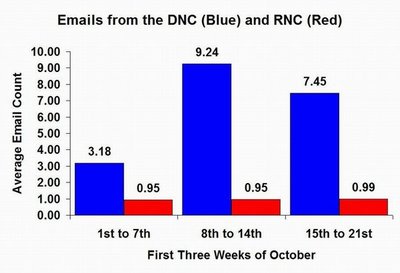October 29, 2004
Democrats outgunning GOP in e-mail wars, researchers find
In the closing weeks of a tight presidential race, the Democratic National Committee has been out-e-mailing its Republican counterpart, a research team of University of Washington students has found.
The 100 students, who signed up to receive campaign e-mails from both parties, found that the Democratic Party not only sent them at least three times as many e-mails as the Republicans, but it was far faster at sending out spin messages after each of the three debates.
The study covered the first three weeks of October.
“The speculation is that a more rapid and effective use of e-mail will lead to an advantage in the race for presidency,” said Peter Fotheringham, a UW senior and one of the study’s authors. “As demonstrated during the debates, political spin is created in real time and therefore can have a direct result on who is declared the victor in the polls.”
After each of the three debates, Democrats were the first and the fastest to respond with e-mail declaring victory and asking for money. Democratic messages vigorously asserting debate victory came within hours of the events, while the Republicans’ e-mails trickled in the next day and did not always convey a firm message about the outcome.
“Historically, political spin has often had a response rate of days and even hours,” Fotheringham said. “We can see that has changed.”
Part of the reason for the Democrats’ faster response, said Philip Howard, the assistant professor of communication who supervised the study, is that the party challenging a White House incumbent may feel a need to be more aggressive in getting its voice heard.
To conduct the study, the 100 students created new e-mail accounts, with two students registering as residents of each state in order to evaluate whether the location of a voter affected the quantity and efficiency of the electronic response, said Andrew Ralston, another student on the project.
In addition, when contacting each party’s Web site, one student from each state registered as having interests in environmental policy and technology (a more liberal profile), while the other registered as having interests in energy policy and homeland security (a more conservative profile).
Thus, the study had one liberal and one conservative virtual personality in each of 50 states collecting e-mail from each political party.
“The Internet’s ability to instantaneously broadcast political messages to the public has become a staple in a candidate’s strategy,” said Howard, whose students in two courses on politics, new media and technology conducted the study. “This is one way to gauge its execution.”
After three weeks, the research team analyzed the quantity and speed of e-mail responses from each party.
Across all 50 states, Republicans averaged approximately one e-mail a week in the first three weeks of October. Democrats, by contrast, sent out about three e-mails in the first week of October, about nine in the second week, and more than seven in the third week.
The study is continuing, Howard said, and the next phase will analyze differences in the substantive content of the e-mails, and the distribution of emails across safe and swing states.
###
For more information:
- Howard, (206) 612-9911 (mobile) or pnhoward@u.washington.edu.
- Fotheringham, (206) 334-5352 or prf@u.washington.edu.
- Ralston, (206) 300-0100 or atr2@u.washington.edu.
The full study is online at http://www.campaignaudit.org

